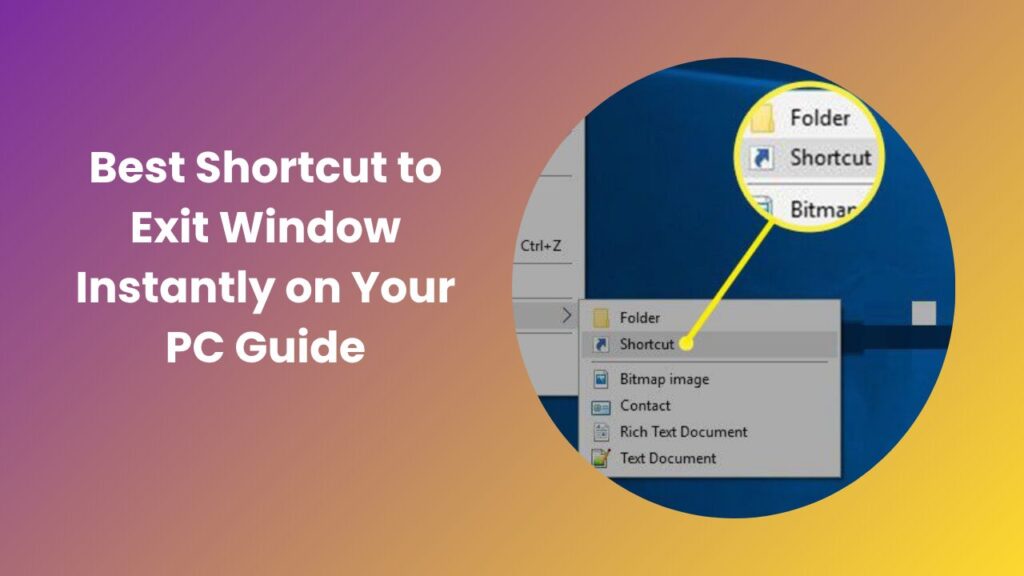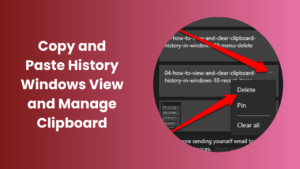Every computer user, from beginners to professionals, knows how frustrating it can be when too many windows clutter the screen. In today’s fast-paced digital world, efficiency is everything and learning the shortcut to exit window is one of the simplest yet most powerful ways to speed up your workflow. Whether you’re closing a frozen program, managing multiple apps, or simply trying to keep your desktop clean, mastering this technique can save you both time and mental energy. The best part is that this shortcut works consistently across different versions of Windows, making it an essential part of everyday computing.
Understanding how these shortcuts work not only makes your computer experience smoother but also helps reduce the wear and tear on your mouse and touchpad. Instead of manually moving your cursor to click the close button every time, keyboard shortcuts offer an instant, precise way to handle tasks. Let’s explore how this method can completely change the way you use your Windows PC, making navigation faster and more convenient than ever before.
Why Window Management Shortcuts Matter
Learning keyboard shortcuts is one of the easiest productivity hacks you can adopt. Each shortcut is designed to minimize unnecessary steps and help users perform actions instantly. In the context of window management, this is especially useful. Most people underestimate how much time they spend simply moving between programs or closing windows. Over time, this adds up to hours of wasted effort.
When you learn the right shortcut combinations, your fingers do all the work while your focus stays uninterrupted. This means fewer distractions, faster response times, and a much cleaner digital workspace. Whether you are switching between tabs, closing apps, or minimizing windows, these keystrokes eliminate the repetitive strain of mouse usage.
In professional environments where multitasking is essential, mastering window shortcuts becomes even more valuable. For instance, designers, developers, and writers often work with several programs open simultaneously. In such cases, the ability to close, switch, or minimize windows quickly keeps workflow seamless and enhances focus.
Common Keyboard Shortcuts for Window Control
Windows provides an extensive set of shortcuts to manage open windows. From minimizing all windows to navigating between desktops, these shortcuts are deeply integrated into the system. Most of them use a combination of keys like Alt, Ctrl, Shift, and Function keys.
For example, pressing Alt + Tab allows users to switch between open windows instantly, while Win + D minimizes all open windows to show the desktop. Similarly, Alt + F4 is the universal command to close a program window. It’s one of the most recognized shortcuts because it works consistently across almost every version of Windows, from XP to Windows 11.
The reason Alt + F4 is so reliable is that it’s part of the core system-level commands recognized by Windows Explorer. When you use it, the system sends an immediate instruction to the active window to close, regardless of what application you’re in. However, if no windows are active, using this shortcut will prompt the system shutdown dialog, giving you an easy way to power off or restart your computer without using your mouse.
Understanding How the Exit Shortcut Works
The Alt + F4 combination essentially tells Windows to close the current focused window or application. When pressed, it interacts with the Windows API (Application Programming Interface) that manages user interface elements. This API receives the command, processes it, and triggers the “close” event within that specific application.
In simpler terms, this is equivalent to clicking the red “X” button at the top right corner of the window. The shortcut, however, is much faster and more reliable, especially when programs become unresponsive. In such cases, the command may take a few seconds to process, but it’s still more efficient than using the mouse.
Moreover, this shortcut doesn’t require you to memorize dozens of different combinations. It’s universally applicable to most software, including browsers, file explorers, text editors, and even games. The consistency of this shortcut across platforms makes it one of the most valuable keyboard skills you can learn.
The Importance of Keyboard Navigation
Keyboard navigation enhances both productivity and ergonomics. Relying solely on the mouse can slow you down, especially when working with multiple windows. Key combinations like Ctrl + W or Alt + Space + C also help close specific tabs or windows in some applications. Once you get comfortable with these shortcuts, your hands rarely need to leave the keyboard.
For professionals who work long hours at a computer, this improvement is significant. The more familiar you become with these commands, the more fluid your workflow feels. It also reduces physical strain, especially for users prone to repetitive strain injuries or wrist discomfort.
Furthermore, keyboard navigation encourages precision. You can control exactly which window or tab to close without accidentally clicking the wrong one. This control is particularly beneficial when working on important tasks where errors could result in data loss or disrupted progress.
When the Shortcut Fails to Work
Although the Alt + F4 shortcut is extremely reliable, there are rare instances where it might not function as expected. For example, if an application freezes or becomes unresponsive, Windows may delay processing the command. In such cases, pressing Ctrl + Shift + Esc opens the Task Manager, allowing you to manually end the task.
Another reason the shortcut might not work is if certain background utilities or games override default system key bindings. Some software developers customize their applications to use specific keyboard combinations for in-game commands or special actions. If that happens, you can always revert to system defaults or temporarily switch out of full-screen mode to regain control.
System updates, third-party software, or keyboard driver issues can also interfere with shortcut recognition. Ensuring your system and drivers are up to date helps maintain smooth shortcut functionality.
How the Shortcut Improves Workflow Efficiency
The shortcut to exit window plays a surprisingly large role in workflow efficiency. Think about how many times per day you open and close windows. Each time you use the mouse, it requires focus, aim, and movement. But using a simple keyboard shortcut removes all of that friction. Over time, these seconds saved per action accumulate into noticeable time savings across the workday.
In workplaces where multitasking and responsiveness are critical, mastering this shortcut helps users stay focused. For example, quickly closing pop-up windows, unnecessary tabs, or resource-heavy applications keeps your system running smoothly and reduces distractions. It’s not just about closing windows faster it’s about maintaining a more organized, distraction-free environment that supports deep work and better concentration.
Tips for Building Muscle Memory with Shortcuts
The most effective way to become fluent in keyboard shortcuts is through consistent practice. Start by consciously using the Alt + F4 command whenever you need to close a window. Over time, your fingers will naturally perform the combination without thinking.
If you’re transitioning from heavy mouse usage, this may take a little adjustment. Consider spending a few minutes each day practicing shortcuts until they become second nature. You can even combine this learning with other navigation commands such as Win + Tab for virtual desktops or Ctrl + Tab for switching browser tabs.
Once you develop muscle memory, you’ll notice a dramatic improvement in your overall computer speed and responsiveness. You’ll also gain a sense of control and mastery that makes everyday computing tasks far less tedious.
Best Practices for Smooth System Performance
Keyboard shortcuts work best when your system runs efficiently. Keeping your operating system clean, updated, and free from unnecessary background processes ensures shortcuts respond instantly. Regularly clearing temporary files, disabling startup bloatware, and managing system resources keeps everything operating at peak performance.
Additionally, make sure your keyboard is functioning properly. Sticky or unresponsive keys can cause shortcuts to fail intermittently. If you often work on a laptop, consider connecting an external keyboard for better tactile feedback and reduced typing fatigue.
Finally, familiarize yourself with accessibility settings in Windows. Many users don’t realize that Windows offers customization options for keyboard behavior. For instance, Sticky Keys or Filter Keys settings can sometimes interfere with shortcut input, so knowing where these controls are can help you fine-tune your experience.
Conclusion
In a world where every second counts, learning the shortcut to exit window is one of the simplest yet most effective ways to enhance your productivity. It may seem like a small change, but over time it transforms how you interact with your computer. By reducing reliance on the mouse, improving precision, and speeding up your workflow, this shortcut becomes a habit that pays dividends daily. Once mastered, it feels as natural as breathing an effortless skill that keeps your digital workspace efficient, tidy, and stress-free.
FAQs
What is the main shortcut to close a window on Windows?
The main shortcut is Alt + F4, which instantly closes the active window or program. It works across most Windows applications and versions.
Why doesn’t Alt + F4 work sometimes?
It may fail if the app is frozen, your keyboard isn’t responding, or the program overrides system shortcuts. Try using Task Manager in such cases.
Can I use a different shortcut to close browser tabs?
Yes, in most browsers like Chrome or Edge, Ctrl + W closes the current tab, while Ctrl + Shift + W closes the entire browser window.
Does the shortcut work the same on laptops?
Yes, but some laptops require pressing the Fn key along with Alt + F4 since function keys often have dual purposes like volume or brightness.
Is there a difference between closing and minimizing windows?
Yes. Closing completely ends the app, while minimizing hides it temporarily so you can reopen it without restarting the program.
How can I improve my overall shortcut efficiency?
Practice daily until the commands feel natural. Combine common shortcuts like Alt + Tab or Win + D to streamline your workflow.
Can I customize my own shortcuts in Windows?
You can create custom shortcuts for opening or managing apps, but system shortcuts like Alt + F4 can’t be changed for stability reasons.





